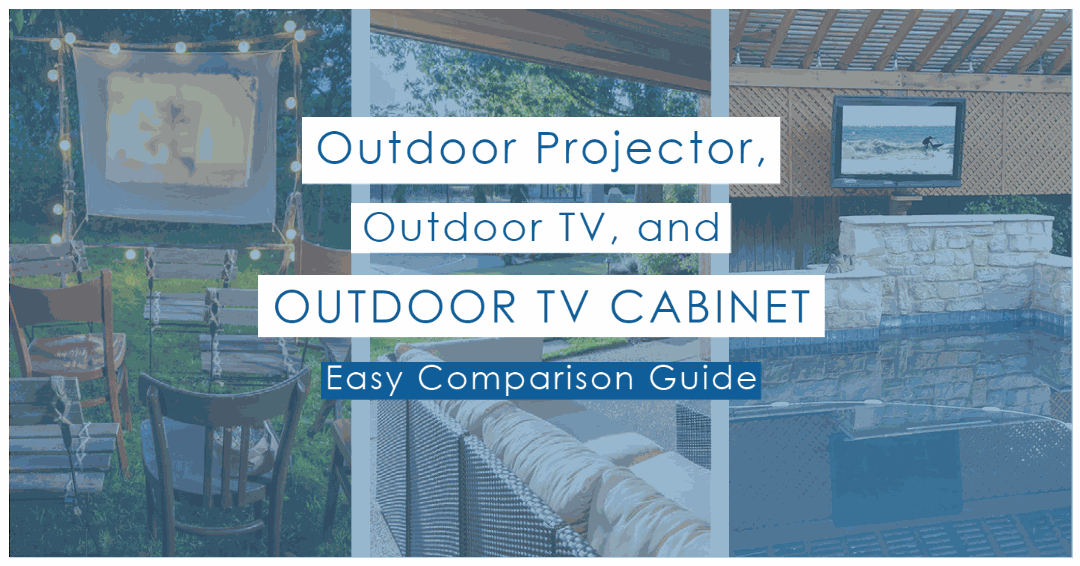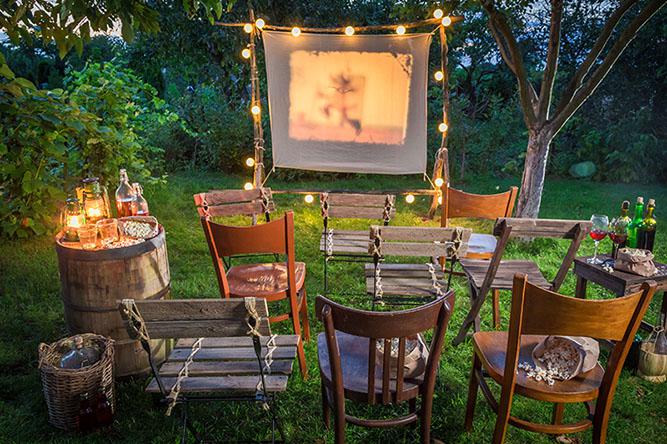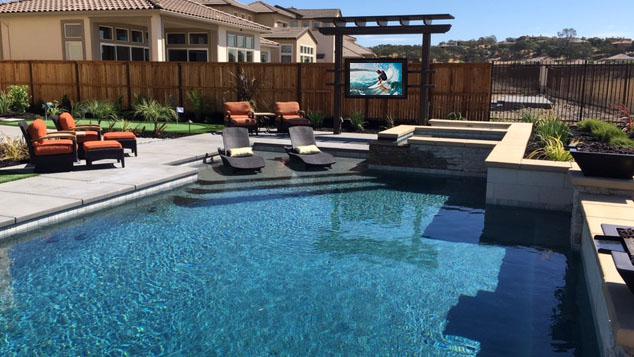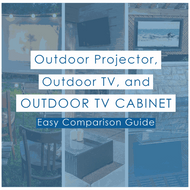Outdoor Projector Screen Vs Outdoor TV Cover Vs Outdoor TV
Posted by E. Allen on 29th Oct 2020

Is an Outdoor Projector, Outdoor TV, or Outdoor TV Cover Better?
Be it winter, spring, summer, or fall, nothing is quite as thrilling in the world of outdoor living spaces as a beautiful outdoor home theater. In recent years there has been a huge explosion in the number of people bringing the indoors out and investing in an outdoor home theater, allowing them to enjoy the outdoors all year round.
However, if you’re new to this game, the information can be a little overwhelming. If you’ve arrived at this article, you’re trying to assess the pros and cons of an outdoor projector screen, outdoor TV, or outdoor TV cover (cabinet). These different options most certainly have their advantages and disadvantages. Not to worry, the insights below should help clear things up for you.
Article Table of Context
Are Outdoor Projectors Weatherproof?
What are the Pros and Cons of Outdoor Projectors?
Can a Regular TV Be Used Outdoors?
What is an Outdoor TV Cover?
Is an Outdoor Projector, Outdoor TV, or Outdoor TV Cover Better?
Are Outdoor Projectors Weatherproof?
Essentially, the answer is no. Some sources, such as this Tech Sounded article explain that outdoor projectors are designed for temporary outdoor use. You can leave an outdoor projector and outdoor projector screen outside. But do so knowing it may not live long at all. The elements like rain, dust, wind, sun, and more will destroy it.
What are the Pros and Cons of Outdoor Projectors?
Outdoor projector screens can be very large. Large picture screen size was once the biggest advantage to getting an outdoor projector. However, these days alternatives come in with extravagantly large sizes as well.
Some people prefer to only watch TV outside on rare occasion and it not be a fixture in the yard, so depending on the size a projector paired with an outdoor projector screen can be a good portable temporary solution to take outside because it could be compact and lightweight. If you do want an ongoing outdoor home theater you can use anytime, an outdoor TV cabinet is the way to go.
While projectors can be lightweight and portable, they can also be a hassle to set up and handle because they require both a projector as well as a screen for viewing, plus typically you will need to invest in add-on items such as speakers and cooling vents. There is the stress of figuring out where to set up all those elements and bring them inside and outside every time you want to use them. You’ll also have to figure out what media device such as Roku or a blue ray player that you’ll pair with it and risk those in the outdoor weather.

Unless you opt for a makeshift DIY at home projector set up, a projector, plus a projector screen, plus any add-on features gets pricey fast to where you can easily end up spending in the $1500 to $2000 ballpark but for a lower quality back yard outdoor viewing experience than other alternatives.
At the end of the day, outdoor projectors are a large screen portable option but may not be a simple outdoor home theater solution. Picture and sound quality are a gamble in general with projectors, but especially outside they aren’t usually great quality with things like sunlight which can wash out the picture and wind that easily distorts sound. Many times, aesthetic is also a concern. For anyone looking to keep a sleek outdoor TV set up, an outdoor TV enclosure may be a better route.
What is the Difference Between an Outdoor TV and Indoor TV?
An indoor TV is simply your typical TV which is not designed for impact or weather resistance. An outdoor TV is marketed specifically as an outdoor TV designed to be placed outside. Theoretically an outdoor TV is a weatherproof TV that can be placed outdoors… however, it is good to be aware that typically these TVs are meant for mild semi-outdoor situations like on a covered screened in porch in very mild weather climates where threats like extreme hot or cold temperatures, flying objects, wind, dust, salt water air, theft, tampering, bugs, and similar threats are not an issue. Some outdoor TVs are being developed to better meet those outdoor threats, but they are extremely expensive and still don’t offer complete peace of mind for an outdoor setting. Electronics and outdoor elements have never mixed well, and this is still true for outdoor TVs. However, there are outdoor TV cabinets that are built for almost any outdoor or harsh environment.
Can a Regular TV Be Used Outdoors?
An indoor TV should not be placed outside unless it is enclosed in an outdoor TV enclosure. There are many things that will likely render your standard indoor TV unusable in a pretty short period of time if left outside. Aside from the issue that if it gets rained on it will most likely be broken immediately, there are other things that significantly shorten the lifespan of an indoor TV being used outdoors even if well protected under an overhang. Things like bugs, moisture, condensation, flying objects, and theft are threats to consider.
What is an Outdoor TV Cover?
An outdoor TV cover is a specifically engineered and designed enclosure that protects TVs in harsh environments. Popular for both residential and commercial markets, a true top quality and robust outdoor TV cabinet is shatterproof and protects from rain, dust, water, extreme temperatures, moisture, tampering, theft, bugs, and much more. An outdoor TV cover may also be referred to as an outdoor TV enclosure, outdoor TV case, outdoor TV box, or outdoor TV cabinet.

Is an Outdoor Projector, Outdoor TV, or Outdoor TV Cover Better?
Here is a comparison guide to make decision making as easy as possible for your specific needs.
Outdoor Projector, Outdoor TV & Outdoor TV Cover Comparison Guide
Outdoor Projectors:
Functionality and Design – The viewing experience of watching footage on an outdoor projector screen is a direct viewing experience without any front screen obstruction like a protective front panel. Depending on the type of screen and install there may be rippling and movement of the screen from wind and outdoor elements. Color and sound may be less dependable than that of a TV. An outdoor projector must be paired with an outdoor projector screen and most likely outdoor speakers as projectors aren’t known for good sound quality indoors much less outdoors.
Outdoor Usability and Durability – Many sources such as this article “ Can You Leave Your Outdoor Movie Screen Out in All Weathers?” explain that outdoor projector screens will not last outside. They are meant for temporary outdoor use. An outdoor projector screen stands a fair chance of rippling or being torn. Not only the screens, but actual outdoor projectors are also not designed to be left outside for long periods of time. The materials are not as strong as those of outdoor TVs and nowhere near as strong or durable as outdoor TV cases.
Size – Up in the ballpark of close to $7000 there are screen sizes up to 240” which is huge! Reports suggest the most popular movie projector sizes range from 100” to 120”.
Installation and Components – An outdoor projector set up will likely entail integrating the projector screen, the actual projector, probably an external speak system, and the device you want to play content from like a Roku or blue ray player but keep in mind that means you’ll need to risk those devices in the elements.
Quality, Technology, and Specs – Outdoor projectors are now offering up to HD which is an improvement from the past, but indoor TVs are offering upgraded options of HD, Ultra HD (UHD), 2K, and WUXGA. Some outdoor TVs are starting to offer HD. Both outdoor TVs and outdoor projectors do typically run behind on integrating the latest technology and compatibility with modern devices.
Price and Value – Even if you’re investing in lower end options, at minimal typically by the time you include the price of the projector, plus a projector screen, plus any add-on features you can easily end up spending $2000 minimal on a temporary or less quality set up than other alternatives. If you’re aiming for an extremely large screen size, you’ll probably be paying a decent chunk more. At the end of the day, if you’re not looking to exceed 98” in screen size, you’re most likely going to find a better value with an alternative solution. If you’re looking to exceed that screen size, a projector may be your only option.
Outdoor TVs:
Functionality and Design – An outdoor TV viewing experience is basic where you install and view the screen without obstruction. Keep in mind technology and picture quality options are not as well developed as an indoor TV. An outdoor TV is typically designed for mild semi-outdoor settings like on a screened in porch rather than completely outdoor harsh environments like next to a pool.
Outdoor Usability and Durability – An outdoor TV is marketed specifically as an outdoor TV designed to be placed outside… however, typically these TVs are meant for mild semi-outdoor situations like on a covered screened in porch in very mild weather climates where things like extreme hot or cold temperatures, flying objects, wind, dust, salt water air, theft, tampering, bugs, and similar threats are not an issue. Some outdoor TVs are being developed to try to better meet those outdoor threats, but they are very expensive and still don’t offer complete peace of mind for an outdoor setting.
Size – According to “The World’s Largest Outdoor TV is Coming in 2020- and It Will Cost You $1.5 Million” as of 2020, the largest outdoor TV in the world comes in at a whopping 301 inches (that’s 25 feet). But it will cost $1.5 million! 55” to 75” are popular outdoor TV sizes.
Installation and Components – An outdoor TV install typically just involves installing the outdoor TV and the device you want to play content from like a Roku or blue ray player but keep in mind that means you’ll need to risk those devices in the elements or figure out how to keep them safe outdoors. An external speaker system is optional.
Quality, Technology, and Specs – In general, outdoor TVs are typically behind regular TVs when it comes to tech. Some outdoor TVs are starting to offer HD and various features. But indoor TVs still lead the way in tech development by far over outdoor TVs or projectors with Ultra HD (UHD), 2K, 4K, WUXGA, and many more options. So, placing an indoor TV in an outdoor TV enclosure is the leading solution for the latest technology and quality.
Price and Value – Weatherproof TVs come with an alarming price tag. For a mid-range outdoor TV you’re looking in the region of $4000, but don’t be surprised if, for the features you need to really combat the weather and security problems, you end up heading towards $7000. On the other hand, the best quality outdoor TV enclosures start at just $399. Even if you need to buy a TV to go in it (if you don’t have an old one to hand) and need a complete outdoor TV kit, then you’re still looking at massive savings - with prices under $800.
Outdoor TV Covers:
Functionality and Design – Outdoor TV cabinets are enclosures designed to protect TVs in unique environments. The most popular and quality outdoor TV covers (cabinets) offer a sleek enclosure with an anti-glare front panel through which the TV can be viewed. They are not all created equal. Unfortunately, there are low quality options on the market that only provide limited protection, are made of low-quality materials, and don’t offer the same viewing experience as top-quality brands. Be sure to understand the design, features, and materials of the best outdoor TV cabinets .
Outdoor Usability and Durability – The best outdoor TV cases (also called outdoor TV enclosures) are shatterproof and protect from flying objects, extreme temperatures, water, dust, rain, moisture, tampering, theft, and more. These enclosures stand up to snow, severe storms, and more. Some are even used on the coast and on yachts on the ocean to protect TVs from saltwater air.

Size – Outdoor TV enclosures can now be custom made up to an astounding 98” and are available up to 85” in standard sizes.
Installation and Components – An outdoor TV enclosure install simply involves installing the outdoor TV enclosure in your outdoor space. An external speaker system is optional.
Quality, Technology, and Specs – One of the big advantages to outdoor TV cabinets is they allow customers to choose and protect their preferred TV with the latest technology or whatever tech they want in a TV in their price range as well as the devices they’d like to include like Roku, blue ray player, Apple TV, etc. So really, there are no limitations to the technology.
Price and Value – Top-of-the-line outdoor TV enclosures are extremely affordable starting at just $399. Even if you need to buy a TV to go in it (if you don’t have an old one on hand) and need a complete outdoor TV kit, you’re still looking at massive savings - with prices under $800.
So, is an outdoor projector, outdoor TV, or outdoor TV cover better? If you’re looking for a screen size larger than 98” an outdoor projector is probably the way to go if that is in your budget since outdoor TV enclosures aren’t an option larger than 98”. Whether it is for your home or business, if you’re looking for a solution smaller than 98” an outdoor TV cabinet serves the most size options at reasonable prices as well as the option for TVs with the latest technology or the lowest prices. Outdoor TV cases also protect other devices you’ll want to protect outside like Roku or Apple TV, so that’s hard to beat!
Ready to find the best outdoor TV enclosure?


